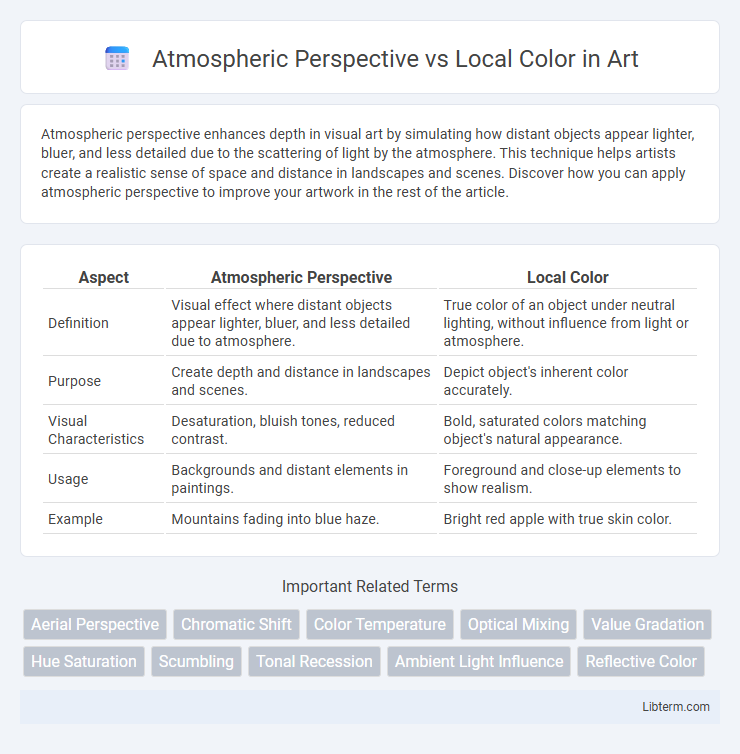Atmospheric perspective enhances depth in visual art by simulating how distant objects appear lighter, bluer, and less detailed due to the scattering of light by the atmosphere. This technique helps artists create a realistic sense of space and distance in landscapes and scenes. Discover how you can apply atmospheric perspective to improve your artwork in the rest of the article.
Table of Comparison
| Aspect | Atmospheric Perspective | Local Color |
|---|---|---|
| Definition | Visual effect where distant objects appear lighter, bluer, and less detailed due to atmosphere. | True color of an object under neutral lighting, without influence from light or atmosphere. |
| Purpose | Create depth and distance in landscapes and scenes. | Depict object's inherent color accurately. |
| Visual Characteristics | Desaturation, bluish tones, reduced contrast. | Bold, saturated colors matching object's natural appearance. |
| Usage | Backgrounds and distant elements in paintings. | Foreground and close-up elements to show realism. |
| Example | Mountains fading into blue haze. | Bright red apple with true skin color. |
Introduction to Atmospheric Perspective and Local Color
Atmospheric perspective refers to the visual effect where distant objects appear lighter, bluer, and less detailed due to the scattering of light by the atmosphere, enhancing depth perception in landscapes. Local color defines the inherent color of an object under neutral lighting conditions, independent of lighting effects or environmental influences. Understanding the distinction between atmospheric perspective and local color is crucial for artists aiming to create realistic spatial depth and accurate color representation in their compositions.
Defining Atmospheric Perspective
Atmospheric perspective is a technique in visual arts that creates the illusion of depth by simulating the effect of the atmosphere on objects viewed at a distance, often characterized by a reduction in contrast, saturation, and detail as objects recede. This contrasts with local color, which refers to the intrinsic color of an object under neutral lighting conditions, unaffected by environmental factors. Understanding atmospheric perspective is essential for artists aiming to depict realistic spatial depth and environmental influence on color perception.
Understanding Local Color
Local color refers to the inherent color of an object influenced by its material properties, independent of lighting or shading conditions. This concept helps artists maintain the true hue of objects even when atmospheric effects alter their appearance at varying distances. Understanding local color allows for more accurate depiction of subjects by distinguishing their base color from changes caused by atmospheric perspective, such as haze or color shifts in distant objects.
Key Differences Between Atmospheric Perspective and Local Color
Atmospheric perspective involves the modulation of color and clarity in objects based on distance, resulting in hues that appear lighter, bluer, and less detailed due to the scattering of light by the atmosphere. Local color refers to the inherent, consistent color of an object regardless of lighting or distance, representing its true surface color under neutral conditions. The key difference lies in atmospheric perspective altering color to convey depth and spatial relationships, while local color remains fixed and does not account for environmental effects.
The Role of Light and Distance in Atmospheric Perspective
Atmospheric perspective relies on the scattering of light over distances, causing distant objects to appear lighter, bluer, and less detailed compared to nearby objects, which retain their local color and sharpness. This effect occurs because particles in the atmosphere diffuse sunlight, reducing contrast and muting hues with increased distance. Artists use this phenomenon to create depth by depicting faraway elements with cooler, desaturated tones while foreground elements maintain vivid local colors.
Local Color: Perception in Neutral Lighting
Local color refers to the inherent color of an object as perceived under neutral lighting conditions, unaffected by shadows or atmospheric effects. It remains constant regardless of surrounding environmental changes, providing a baseline for accurately identifying the object's true color. Unlike atmospheric perspective, which alters colors based on distance and light scattering, local color emphasizes an object's authentic hue in stable, controlled lighting environments.
Atmospheric Perspective in Art History
Atmospheric perspective in art history enhances depth by simulating the effect of the atmosphere on objects viewed at a distance, causing colors to appear lighter, cooler, and less saturated. This technique contrasts with local color, which refers to the true, undisturbed color of an object under neutral lighting. Masters like Leonardo da Vinci and J.M.W. Turner employed atmospheric perspective to create realistic landscapes and a sense of spatial depth.
Techniques for Applying Local Color in Painting
Techniques for applying local color in painting focus on capturing the inherent hue of objects without atmospheric influence, often using solid, unmixed pigments to portray accurate and vivid color representation. Artists emphasize clean edges and consistent saturation to maintain the object's true color, creating a sense of stability and realism. This contrasts with atmospheric perspective, which involves blending, softening, and desaturating colors to mimic the effects of distance and light scattering in the environment.
When to Use Atmospheric Perspective vs Local Color
Atmospheric perspective is ideal for depicting depth and distance in landscapes by gradually desaturating colors and reducing contrast, simulating how air and light affect objects far away. Local color is best suited for close-up subjects or still life where accurate, consistent color representation is crucial for realism and detailed observation. Choosing between atmospheric perspective and local color depends on whether the artwork aims to emphasize spatial depth or precise color fidelity.
Impact on Viewer Perception and Visual Storytelling
Atmospheric perspective uses color shifts, desaturation, and reduced contrast to create depth and suggest distance, enhancing spatial realism and emotional mood in a scene. Local color preserves an object's true color regardless of lighting, emphasizing its physical characteristics and promoting clarity and object recognition. The interplay of atmospheric perspective and local color shapes viewer perception by guiding focus, setting ambiance, and reinforcing narrative elements in visual storytelling.
Atmospheric Perspective Infographic

 libterm.com
libterm.com